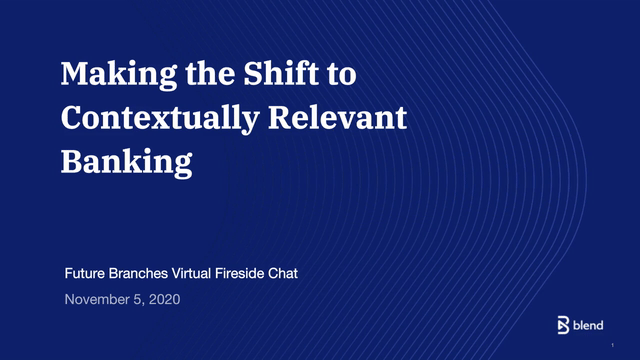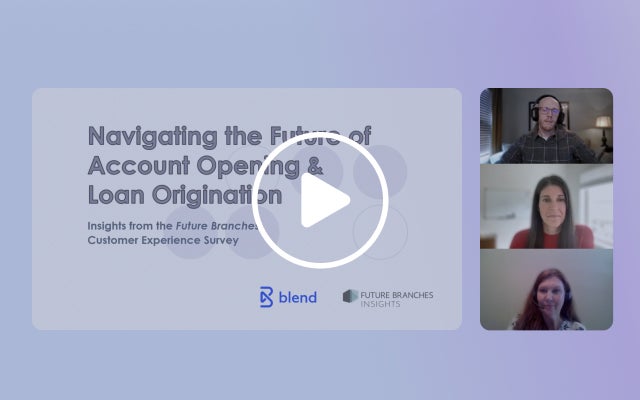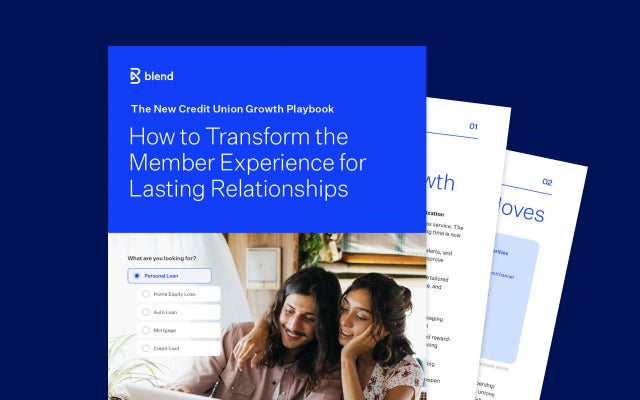November 9, 2020 in Thought leadership
Webinar: Making the shift to contextually relevant banking

As financial institutions continue to navigate the post-COVID world, they’ve increasingly looked to update and improve the way they interact with customers — from the technology they use to how they reach out. In this webinar, Scott Hirsch, Blend’s product marketing lead, and guest speaker Alyson Clarke, a principal analyst at Forrester Consulting, discuss the industry’s shift to contextually relevant banking as part of the Future Branches Virtual Fireside Chat webinar series.
According to Clarke, contextually relevant banking is centered on the idea of putting the customer first, understanding their needs and where they are in their lives, and communicating to them in a way that is relevant to that moment. So, for example, the communication to a person who was just married would differ from those to one who was saving for a new car.
Read on for three key takeaways or watch the on-demand video below.

Too busy to watch? Download the executive summary here
1. Banks currently lack differentiation — and that could be a problem
Forrester’s research shows that most financial institutions are more or less the same in the eyes of consumers. The Forrester Analytics Consumer Technographics Financial Services Online Benchmark Recontact Survey, completed in 2019, revealed that across all age groups, from millennials to the golden generation, between 22 percent to 33 percent view banks as being undifferentiated. For financial institutions looking to break away from the pack, this presents a serious problem.
2. To differentiate, be both useful and personal
The key to successful personalization, according to Clarke, is ensuring that your communications help the consumer. Rather than focus on what products could be sold to the consumer, first understand the consumer’s needs using the context provided by the data they provided. Then, communicate with them in a way that’s appropriate and helpful for them in the moment they are in. Using the context that you have in this way, you can better meet customer needs and elicit feelings of appreciation, respect, and value. Forrester’s research shows that these three emotions are most correlated with customer loyalty and revenue growth for banks.
According to Clarke, there are four key ways in which you can do this, and any communication should include at least one, and ideally more than one, of the following:
Inform — Help inform and frame the situation for the customer. This could be providing options for established customer goals (saving for a car or house, for example).
Guide — Help to simplify things and guide customers to what they need. Demonstrate that you are a trusted advisor by cutting through the noise and providing not just information but understanding. This could include providing a means of comparing the customer’s various options for saving for a car.
Advise — Extend customers’ options and advise them of other things they may need.
Care — Show that you care and think of them as more than a source of revenue. Customers who feel valued, appreciated, and confident are more loyal. Ensure that the way you use the context you have for customers feels caring and not creepy.
3. To optimize, take a systematic approach to identifying moments for personalization
In order to be useful to the customer says Clarke, you need to make sure you’re communicating with them both in the right way and at the right time. The best way to do that is to take a systematic approach. She suggests starting with mapping out the customer journey and identifying the moments in that journey where personalized, contextually relevant experiences will have the most significant impact.
Ultimately, to differentiate themselves from their competitors, financial institutions should endeavor to treat customers not in a transactional manner but in a way that shows understanding and compassion through personalized, relevant communication. In this way, they can provide more value to the customer and ultimately create the level of stickiness with your customers that makes it much harder for competitors to compete.
Find out what we're up to!
Subscribe to get Blend news, customer stories, events, and industry insights.



